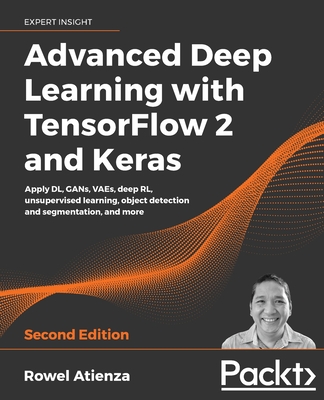Hands-On Deep Learning Algorithms with Python (Paperback)
暫譯: 實作深度學習演算法與Python
Ravichandiran, Sudharsan
- 出版商: Packt Publishing
- 出版日期: 2019-07-29
- 售價: $1,500
- 貴賓價: 9.5 折 $1,425
- 語言: 英文
- 頁數: 512
- 裝訂: Quality Paper - also called trade paper
- ISBN: 1789344158
- ISBN-13: 9781789344158
-
相關分類:
DeepLearning
-
相關翻譯:
Python 深度學習算法實戰 (簡中版)
買這商品的人也買了...
-
 $1,188Fedora 11 and Red Hat Enterprise Linux Bible (Paperback)
$1,188Fedora 11 and Red Hat Enterprise Linux Bible (Paperback) -
 離散數學 最新修訂版
離散數學 最新修訂版$800$680 -
 Python 設計模式深入解析 (Mastering Python Design Patterns)
Python 設計模式深入解析 (Mastering Python Design Patterns)$360$281 -
 不再聽不懂!圖解網站建置與開發
不再聽不懂!圖解網站建置與開發$450$383 -
 Python 函式庫語法範例字典
Python 函式庫語法範例字典$450$356 -
 演算法之美:隱藏在資料結構背後的原理 (C++版)
演算法之美:隱藏在資料結構背後的原理 (C++版)$650$507 -
 為你自己學 Git
為你自己學 Git$500$390 -
 Python 技術者們 - 實踐! 帶你一步一腳印由初學到精通
Python 技術者們 - 實踐! 帶你一步一腳印由初學到精通$650$514 -
 Python 與 LINE Bot 機器人全面實戰特訓班 (附203分鐘影音教學/範例程式)
Python 與 LINE Bot 機器人全面實戰特訓班 (附203分鐘影音教學/範例程式)$520$411 -
 Python 技術者們 - 練功!老手帶路教你精通正宗 Python 程式 (The Quick Python Book, 3/e)
Python 技術者們 - 練功!老手帶路教你精通正宗 Python 程式 (The Quick Python Book, 3/e)$780$663 -
 設計師都該懂的包容性網頁 UI/UX 設計模式:知名設計師教你親和性網頁的實作祕密
設計師都該懂的包容性網頁 UI/UX 設計模式:知名設計師教你親和性網頁的實作祕密$450$351 -
 邁向 Linux 工程師之路:Superuser 一定要懂的技術與運用, 2/e (How Linux Works: What Every Superuser Should Know, 2/e)
邁向 Linux 工程師之路:Superuser 一定要懂的技術與運用, 2/e (How Linux Works: What Every Superuser Should Know, 2/e)$600$468 -
 JavaScript 技術手冊
JavaScript 技術手冊$560$420 -
 PowerShell 流程自動化攻略 (Powershell for Sysadmins: A Hands-On Guide to Automating Your Workflow)
PowerShell 流程自動化攻略 (Powershell for Sysadmins: A Hands-On Guide to Automating Your Workflow)$500$425 -
 精通資料視覺化 : 用試算表與程式說故事 (Hands-On Data Visualization: Interactive Storytelling from Spreadsheets to Code)
精通資料視覺化 : 用試算表與程式說故事 (Hands-On Data Visualization: Interactive Storytelling from Spreadsheets to Code)$680$537 -
 打下最紮實 AI 基礎不依賴套件:手刻機器學習神經網路穩健前進
打下最紮實 AI 基礎不依賴套件:手刻機器學習神經網路穩健前進$1,200$948 -
 強健的 Python|撰寫潔淨且可維護的程式碼 (Robust Python: Write Clean and Maintainable Code)
強健的 Python|撰寫潔淨且可維護的程式碼 (Robust Python: Write Clean and Maintainable Code)$680$537 -
 Template Metaprogramming with C++: Learn everything about C++ templates and unlock the power of template metaprogramming (Paperback)
Template Metaprogramming with C++: Learn everything about C++ templates and unlock the power of template metaprogramming (Paperback)$1,740$1,653 -
 邁向 Linux 工程師之路:Superuser 一定要懂的技術與運用, 3/e (How Linux Works : What Every Superuser Should Know, 3/e)
邁向 Linux 工程師之路:Superuser 一定要懂的技術與運用, 3/e (How Linux Works : What Every Superuser Should Know, 3/e)$780$608 -
 精通無瑕程式碼:工程師也能斷捨離!消除複雜度、提升效率的 17個關鍵技法 (The Art of Clean Code: Best Practices to Eliminate Complexity and Simplify Your Life)
精通無瑕程式碼:工程師也能斷捨離!消除複雜度、提升效率的 17個關鍵技法 (The Art of Clean Code: Best Practices to Eliminate Complexity and Simplify Your Life)$600$468 -
 全格局使用 PyTorch - 深度學習和圖神經網路 - 基礎篇, 2/e
全格局使用 PyTorch - 深度學習和圖神經網路 - 基礎篇, 2/e$880$695 -
 生成式 AI 提示工程|以前瞻性的設計打造穩定、可信任的 AI 解決方案 (Prompt Engineering for Generative AI: Future-Proof Inputs for Reliable AI Outputs)
生成式 AI 提示工程|以前瞻性的設計打造穩定、可信任的 AI 解決方案 (Prompt Engineering for Generative AI: Future-Proof Inputs for Reliable AI Outputs)$880$695 -
 LLM 語意理解與生成技術完全開發 (Hands-On Large Language Models)
LLM 語意理解與生成技術完全開發 (Hands-On Large Language Models)$980$774 -
 LangChain 學習手冊|使用 LangChain 與 LangGraph 建構 AI 與 LLM 應用程式 (Learning LangChain: Building AI and LLM Applications with LangChain and LangGraph)
LangChain 學習手冊|使用 LangChain 與 LangGraph 建構 AI 與 LLM 應用程式 (Learning LangChain: Building AI and LLM Applications with LangChain and LangGraph)$680$537 -
 LLM 工程師開發手冊 (LLM Engineer's Handbook: Master the art of engineering large language models from concept to production)
LLM 工程師開發手冊 (LLM Engineer's Handbook: Master the art of engineering large language models from concept to production)$1,250$988
相關主題
商品描述
| Learn |
|
|---|---|
| About |
Deep learning is one of the most popular domains in the AI space that allows you to develop multi-layered models of varying complexities.
This book introduces you to popular deep learning algorithms—from basic to advanced—and shows you how to implement them from scratch using TensorFlow. Throughout the book, you will gain insights into each algorithm, the mathematical principles involved, and how to implement it in the best possible manner. The book starts by explaining how you can build your own neural networks, followed by introducing you to TensorFlow, the powerful Python-based library for machine learning and deep learning. Moving on, you will get up to speed with gradient descent variants, such as NAG, AMSGrad, AdaDelta, Adam, and Nadam. The book will then provide you with insights into recurrent neural networks (RNNs) and LSTM and how to generate song lyrics with RNN. Next, you will master the math necessary to work with convolutional and capsule networks, widely used for image recognition tasks. You will also learn how machines understand the semantics of words and documents using CBOW, skip-gram, and PV-DM. Finally, you will explore GANs, including InfoGAN and LSGAN, and autoencoders, such as contractive autoencoders and VAE.
By the end of this book, you will be equipped with all the skills you need to implement deep learning in your own projects. |
| Features |
|
商品描述(中文翻譯)
更多資訊
學習內容
- 實作從基礎到進階的深度學習演算法
- 掌握深度學習演算法背後的數學原理
- 熟悉梯度下降法及其變體,如 AMSGrad、AdaDelta、Adam 和 Nadam
- 實作循環神經網路,如 RNN、LSTM、GRU 和 seq2seq 模型
- 理解機器如何使用 CNN 和膠囊網路解讀圖像
- 實作不同類型的生成對抗網路,如 CGAN、CycleGAN 和 StackGAN
- 探索各種自編碼器的類型,如稀疏自編碼器、DAE、CAE 和 VAE
關於本書
深度學習是人工智慧領域中最受歡迎的領域之一,允許您開發多層次的模型,具有不同的複雜性。
本書介紹了流行的深度學習演算法——從基礎到進階——並展示了如何使用 TensorFlow 從零開始實作它們。在整本書中,您將深入了解每個演算法、涉及的數學原理,以及如何以最佳方式實作它。書中首先解釋了如何構建自己的神經網路,接著介紹了 TensorFlow,這是一個強大的基於 Python 的機器學習和深度學習庫。接下來,您將熟悉梯度下降法的變體,如 NAG、AMSGrad、AdaDelta、Adam 和 Nadam。然後,本書將提供有關循環神經網路(RNN)和 LSTM 的見解,以及如何使用 RNN 生成歌曲歌詞。接下來,您將掌握處理卷積網路和膠囊網路所需的數學,這些網路廣泛用於圖像識別任務。您還將學習機器如何使用 CBOW、skip-gram 和 PV-DM 理解單詞和文件的語義。最後,您將探索 GAN,包括 InfoGAN 和 LSGAN,以及自編碼器,如收縮自編碼器和 VAE。
在本書結束時,您將具備在自己的專案中實作深度學習所需的所有技能。
特色
- 快速掌握從零開始構建自己的神經網路
- 深入了解深度學習演算法背後的數學原理
- 使用 TensorFlow 實作流行的深度學習演算法,如 CNN、RNN 等































